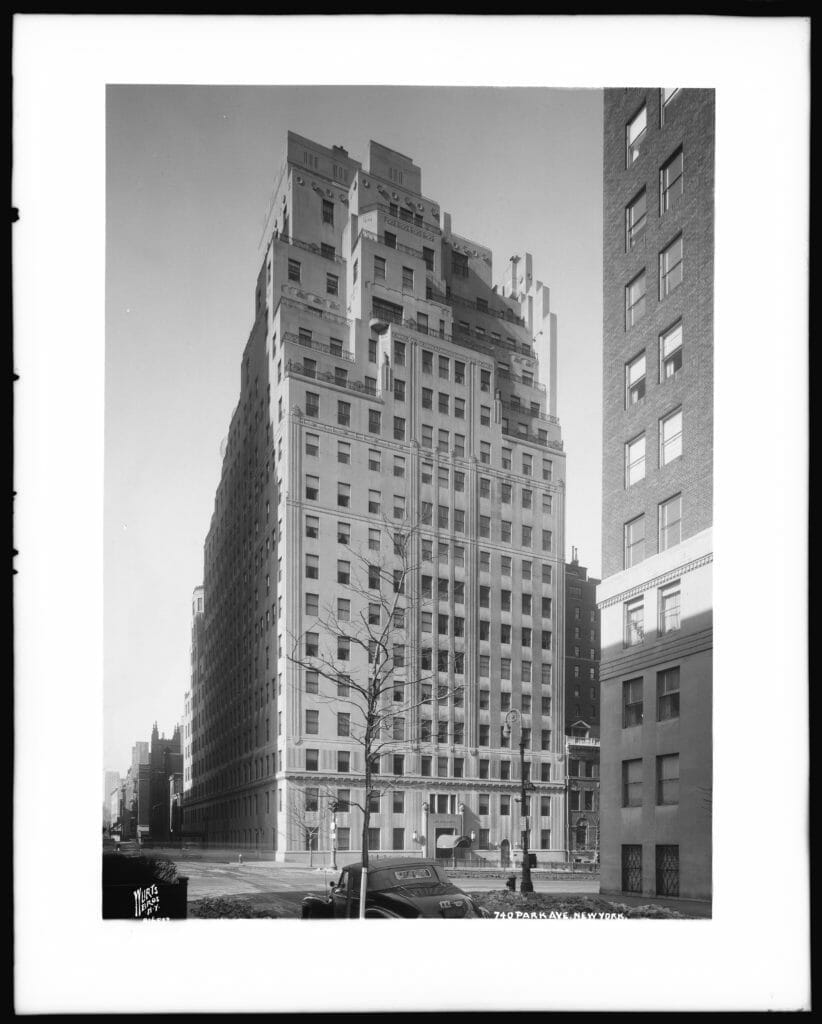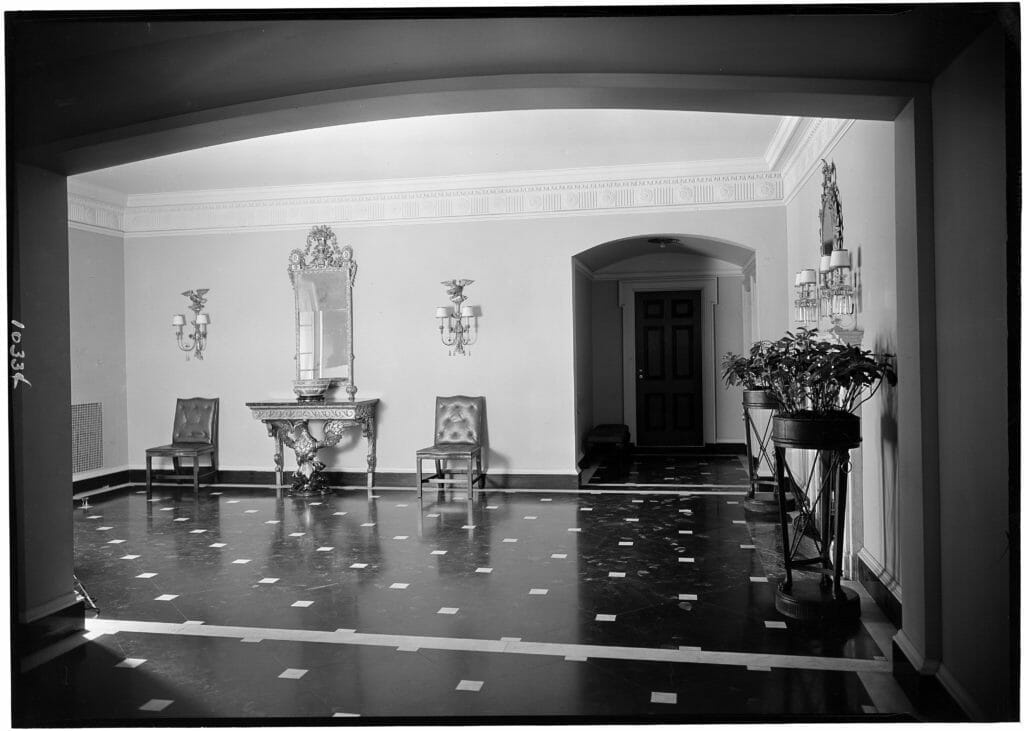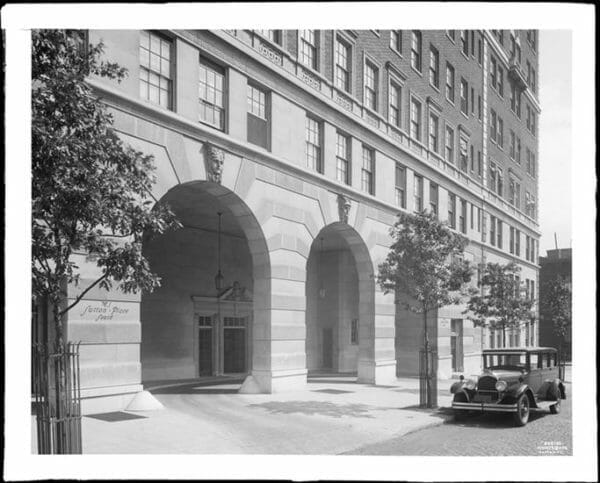On Thursday, May 17, 2018, the Museum of the City of New York (MCNY) will unveils Elegance in the Sky: The Architecture of Rosario Candela, an exhibition that explores architect Rosario Candela, who played a role in shaping luxury living of 20th century Manhattan with the design of the prewar apartment buildings that define the cityscapes of streets like Park and Fifth Avenues and Sutton Place. Candela's high-rises, such as 960 Fifth Avenue, 740 Park Avenue, and One Sutton Place South featured set-back terraces and neo-Georgian and Art Deco ornament that created the look of New York urbanism between the World Wars. The exhibition is designed by Peter Pennoyer Architects. Graphic design is by Tsang Seymour.
Elegance in the Sky tells the story of Rosario Candela, an immigrant architect, who made a name for himself by becoming in transforming the way the wealthiest in New York City lived. Through photographs, ephemera, graphics, domestic furnishings, and digital animation, the exhibition displays how Candela and his colleagues motivated New Yorkers to move from their private homes to "luxury mansions in the sky," thus changing the landscape of the city. MCNY says "Much of the vision of prewarelegance is based on Candela's architectural re-imaginations that have become status symbols for the city with a long-lasting economic impact and history."
Rosario Candela, an immigrant from Italy, came in an era when the city's 19th century mansions and townhouses were being torn down and their residents adapting to apartment living. Working within a community of fellow architects, real estate developers, builders, and interior designers, Candela created residential buildings that mixed single-story, duplex, and triplex units. Some offered private, multi-story "maisonettes" at street level. These structures established standards of living for some of New York's wealthiest citizens. As MCNY spokespersons summarize, "Even today, almost a century after they were built, Candela's buildings rank among the most prized in the city, and the phrase 'designed by Rosario Candela' remains a real estate magnet."
Born in Palermo, Sicily, in 1890 (where his father was a plasterer), Rosario Candela immigrated to the United States around 1910. Although he had only a small grasp of English, he graduated from Columbia University with a degree in architecture in 1915. He set up his own practice by 1920 and was receiving commissions from developers, many of them Italian immigrants like himself, with whom he realized some of his most famous designs.
Working primarily in Manhattan, Candela designed or co-designed about 75 apartment buildings, hitting his peak at the height of the Jazz Age in the late 1920s. The stock market crash of 1929 derailed Candela's architectural career, when he soon turned his attention to a new endeavor - cryptography. He is credited with developing an unbreakable encryption method, wrote two books on the subject, and, starting in 1941, taught a course on cryptanalytics at Hunter College.
Elegance in the Sky focuses on three districts that Candela helped transform: Fifth Avenue, Park Avenue, and Sutton Place. The exhibition showcases vintage and contemporary photographs highlighting the exteriors and interiors of Candela buildings. There is a digital animation of 960 Fifth Avenue, which demonstrates the range of interior designs often hidden by the similarities between the exteriors of his buildings.
Transforming Fifth Avenue
Working mainly in the late 1920s, Candela designed eight luxury apartment buildings on Fifth Avenue across from Central Park. MCNY states that "2 East 70th Street, completed in 1928, captures the street's transformation from a 19th century enclave of primarily private homes to one of apartment towers, but also the balance between history and modernity."
The location had already been through a succession of changes. In the 1870s, merchant Josiah M. Fiske had built a mansion on the site. Its Victorian style dated by the early 20th century, and around 1917, banker C. Ledyard Blair replaced Fiske's mansion with a stately one in the neo-classical style. Slightly more than a decade later, developer Anthony Campagna tore down Blair's mansion to build Candela's structure.
Larger in scale than the Blair mansion, Candela's building nonetheless adopted its immediate predecessor's buff-colored palette, vertical tripartite subdivision, and neo-classical details. The western part of each floor comprised single-floor units with living rooms spanning the building's entire Central Park-facing width.
Park Avenue Rising
By the late 1920s, Park Avenue was, according to the New York Herald Tribune, "a synonym for wealth." Candela contributed to the avenue's status through the ten apartment buildings he completed between 1923 and 1931. His 778 Park Avenue, finished in 1931 at the corner of E. 73rd Street, was the final house of his career on the avenue. This brick-and-limestone tower rose some 20 stories to an asymmetrical pinnacle of setback terraces and a domed and columned pavilion that concealed a water tank.
The avenue's high-style position was a recent phenomenon. During the 1870s, the railroad tracks leading north from Grand Central Depot (today's Grand Central Terminal) were sunk and partially landscaped, and by the next decade Fourth Avenue became "Park Avenue." In 1903, after one of the city's worst railway accidents, New York state outlawed steam locomotives, making it possible to more fully landscape the thoroughfare and sparking the construction of upscale residential apartment buildings by Candela and other prominent architects.
Shaping Sutton Place
Sutton Place, the high-end residential enclave on the East River, was an early 20th century invention conceived by real estate developers, builders, and architects, including Rosario Candela. Formerly Avenue A, the street had been renamed "Sutton Place" shortly after Effingham B. Sutton created a row of brownstones between 57th and 58th Streets in 1875.
Sutton Place's transformation into its current form began around 1920, when several wealthy socialites, including Anne Harriman Vanderbilt and Anne Morgan (daughter of financier J.P. Morgan), built townhouses on the site in the Colonial Revival style. "The efforts of these socially prominent figures sparked a real estate land rush." Over the next decade, developers such as the Paterno brothers and architects like Candela designed and constructed the numerous luxury apartment houses that define the neighborhood today. Candela's first apartment building there was 1 Sutton Place South. It was followed by four other apartment buildings and associates within a three-block area.
Marketing Rosario Candela
While the areas that Candela helped to transform are now sought-after places, this was not always the case. As the marketing of Candela buildings underscores, real estate agents and developers used images and text to convince wealthy individuals to give up their private residences for apartment living. Luxury apartments allowed tenants to retain their former homes' sense of domestic privacy, large rooms for socializing, separation of servant and master spaces, and amenities such as communal lounges and dining rooms. A major focus of marketing literature was to persuade owners of the financial safety and convenience of living in "cooperative" apartment buildings, whose occupants held shares in a corporation that owned the building. This form of ownership rose in popularity in the 1920s in New York City, when co-ops attracted wealthy buyers, because prospective tenants could be screened for their social standing and financial worth.
When
May 17 - October 28, 2018
Where
Museum of the City of New York
1220 Fifth Avenue @ 103rd St.
Ramp access @ 104th St.
New York, NY 10029
Tickets
Adults - $18
Seniors (65+), students - $12 with I.D.
Ages 19 and under - Free
Members - Free






